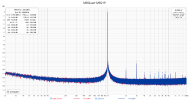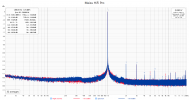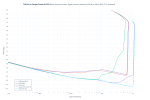-
Welcome to ASR. There are many reviews of audio hardware and expert members to help answer your questions. Click here to have your audio equipment measured for free!
You are using an out of date browser. It may not display this or other websites correctly.
You should upgrade or use an alternative browser.
You should upgrade or use an alternative browser.
A Thread Dedicated to Cirrus Logic CS43131
staticV3
Grand Contributor
- Joined
- Aug 29, 2019
- Messages
- 12,734
- Likes
- 21,258
Zek
Major Contributor
- Joined
- Feb 17, 2018
- Messages
- 1,874
- Likes
- 2,453
Is there any link to all those measurements?If you're interested in specific measurements, feel free to tell me.
staticV3
Grand Contributor
- Joined
- Aug 29, 2019
- Messages
- 12,734
- Likes
- 21,258
They don't exist yet.Is there any link to all those measurements?
If you're interested in something specific (Jitter of x, Noise of y, THD+N vs Power of z), then feel free to tell me and I'll measure and post the results.
Please do measure power x THD+N into 32 ohms of all 5? Tks a lot.They don't exist yet.
If you're interested in something specific (Jitter of x, Noise of y, THD+N vs Power of z), then feel free to tell me and I'll measure and post the results.
staticV3
Grand Contributor
- Joined
- Aug 29, 2019
- Messages
- 12,734
- Likes
- 21,258
Meizu Pro is the best but unobtanium. The next best is the ugreen, surprisingly for me.
Can you send me the link on Aliexpress for the ugreen with 43131? I can only find the KT0210 ones.
Tks
Can you send me the link on Aliexpress for the ugreen with 43131? I can only find the KT0210 ones.
Tks
staticV3
Grand Contributor
- Joined
- Aug 29, 2019
- Messages
- 12,734
- Likes
- 21,258
The only place where I could still find the Ugreen is here: https://www.ebay.com/itm/255096654642Can you send me the link on Aliexpress for the ugreen with 43131? I can only find the KT0210 ones.
Searching for the model number helps, so "Ugreen 80583".
It was probably discontinued along with the Meizu Pro.... Frustrating.
Has anyone measured CS43131 in this form factor? I'd love to go back to the Apple Dongle dimensions, but my memory of the 31993 EM noise is still fresh.
View attachment 312953
cat /proc/asound/card1/stream0
TTGK Company Type-C HiFi Audio Adapter at usb-0000:00:14.0-4, high speed : USB Audio
Playback:
Status: Stop
Interface 2
Altset 1
Format: S16_LE
Channels: 2
Endpoint: 0x03 (3 OUT) (ASYNC)
Rates: 44100, 48000, 88200, 96000, 176400, 192000, 352800, 384000
Data packet interval: 125 us
Bits: 16
Channel map: FL FR
Sync Endpoint: 0x84 (4 IN)
Sync EP Interface: 2
Sync EP Altset: 1
Implicit Feedback Mode: No
Interface 2
Altset 2
Format: S24_3LE
Channels: 2
Endpoint: 0x03 (3 OUT) (ASYNC)
Rates: 44100, 48000, 88200, 96000, 176400, 192000, 352800, 384000
Data packet interval: 125 us
Bits: 24
Channel map: FL FR
Sync Endpoint: 0x84 (4 IN)
Sync EP Interface: 2
Sync EP Altset: 2
Implicit Feedback Mode: No
Interface 2
Altset 3
Format: S32_LE
Channels: 2
Endpoint: 0x03 (3 OUT) (ASYNC)
Rates: 44100, 48000, 88200, 96000, 176400, 192000, 352800, 384000
Data packet interval: 125 us
Bits: 32
Channel map: FL FR
Sync Endpoint: 0x84 (4 IN)
Sync EP Interface: 2
Sync EP Altset: 3
Implicit Feedback Mode: No
Interface 2
Altset 4
Format: SPECIAL
Channels: 2
Endpoint: 0x03 (3 OUT) (ASYNC)
Rates: 44100, 48000, 88200, 96000, 176400, 192000, 352800, 384000
Data packet interval: 125 us
Bits: 32
DSD raw: DOP=0, bitrev=0
Channel map: FL FR
Sync Endpoint: 0x84 (4 IN)
Sync EP Interface: 2
Sync EP Altset: 4
Implicit Feedback Mode: No
cat /proc/asound/card1/usbmixer
USB Mixer: usb_id=0x262a0001, ctrlif=1, ctlerr=0
Card: TTGK Company Type-C HiFi Audio Adapter at usb-0000:00:14.0-4, high speed
Unit: 1
Control: name="Clock Source 1 Validity", index=0
Info: id=1, control=2, cmask=0x0, channels=1, type="BOOLEAN"
Volume: min=0, max=1, dBmin=0, dBmax=0
Unit: 10
Control: name="PCM Playback Volume", index=0
Info: id=10, control=2, cmask=0x3, channels=2, type="S16"
Volume: min=-16128, max=0, dBmin=-6300, dBmax=0
Unit: 10
Control: name="PCM Playback Switch", index=0
Info: id=10, control=1, cmask=0x0, channels=1, type="INV_BOOLEAN"
Volume: min=0, max=1, dBmin=0, dBmax=0
... and what is this ???
A proof of legitimacy. It really is, as advertised, a cs43131 in a dongle.
Can you tell me does it support microphone?I just got a JCALLY JM30 dongle with the CS43131. I could not be happier. This plays so well with my phone that I have no desire for a DAP. I had a $700 DAP with AK chips and while I can not compare directly I feel that the JM30 is a better listen. The JM30 impresses me more than the DAP ever did.
Sorry, no idea.Can you tell me does it support microphone?
Just ordered a Jcally JM20 as a backup for my loved Ugreen HiFi Pro, I'm curious about the above information, is it taken from JM20 or other "no-name" CS431131 dongle? Or can anyone using the JM20 on Linux post the result of the command?Interface 2 Altset 4 Format: SPECIAL Channels: 2 Endpoint: 0x03 (3 OUT) (ASYNC) Rates: 44100, 48000, 88200, 96000, 176400, 192000, 352800, 384000 Data packet interval: 125 us Bits: 32 DSD raw: DOP=0, bitrev=0 Channel map: FL FR Sync Endpoint: 0x84 (4 IN) Sync EP Interface: 2 Sync EP Altset: 4 Implicit Feedback Mode: No
I ask because the Ugreen doesn't expose that "Altset 4 - Special format" for DSD, so I suppose it using a different usb-bridge, indeed it seems to support only DoP mode
Not really concerned about playing dsd, just out of curiosity about the various implementation around this great CS chip.
Not really surprising since the Ugreen has the same architecture of Meizu Pro with OPA1622 after CS43141 to give some more current in low ohm load.Meizu Pro is the best but unobtanium. The next best is the ugreen, surprisingly for me.
Really unfortunate they all went discontinued too soon.
I would love that @IVX or anyone that is familiar with the subject chimes in here one day to explain in layman terms what is the problem with this chip. From what I could understand, in between other things, it tricks the dynamic range so that it appears to be better than actually is or something like that. Most important I think is if these issues are purely academic or have any consequences to the user.
Some discussion here:
 www.diyaudio.com
www.diyaudio.com
Some discussion here:
Is the CS43198 a same fake?
Hi! Everybody knows Cirrus Logic DACs CS43131 and CS43198. Once I noticed a discrepancy between the sound of my CS43131 and its measurements. After some research, I came to the conclusion that its brilliant results are fake. I have not any source with CS43198, so it would be interesting if...
staticV3
Grand Contributor
- Joined
- Aug 29, 2019
- Messages
- 12,734
- Likes
- 21,258
Unless you can hear hiss out of your cs43131-based DAC, the issue is purely academic.From what I could understand, in between other things, it tricks the dynamic range so that it appears to be better than actually is or something like that. Most important I think is if these issues are purely academic or have any consequences to the user.
What some designers (rightly) take issue with is that, unlike ESS with their "DRE" feature, Cirrus doesn't disclose anywhere that their DAC uses such tricks and advertises DR figures as though they were the DAC's inherent DR.
The DR test was created specifically to counteract this sort of trickery where DACs would modulate their noise floor based on the input signal.
Cirrus just created a mechanism that works even with this improved DR test, but didn't tell anyone.
IVX
Major Contributor
right, the DR test shows us 130db(A) but a full scale output 0dbfs looks rather like 120db(A) dynamic range DAC i.e. similar to their old CS4398 + noise reduction. The same as about 384k support, just a fake, the noiseshaper artifacts appeared from 40kHz i.e., it looks like the DAC is 96k of sampling. However, these DACs have very low power consumption, which is again incompatible with real low-noise circuits due to thermal noise(low impedance and high currents are required).
PS: The story behind the DR test is simple, it was needed to detect auto-mute trick, which is also a sort of noise-reduction but the simplest one. DRE(ESS abbreviation Dynamic Range Enhancer) like algorithms change the DAC's gain according to the input signal. It is the same if you have an additional volume slider after the DAC, dynamically controlled by the input content. Let's consider two cases. Input data is a signal at max level i.e. 0dbfs, DRE is completely bypassed in that case and you can see the DAC's noise floor+some noise modulation as is. In the case of CS431** it is around -115db/-118db(A). Case #2: we gonna test AES17 DR i.e. input data has -60dbfs level. DRE multiplying the data by 10x(maybe 5x, or 3x as an example), this is a digital domain operation and may have virtually zero of the residual THD+N. At the same time DRE reduces the output gain by 1/10, using the slider mentioned above. What do we have at the output for now? -115db of DAC's noise will be reduced by a factor 10x i.e. for a 20db, and you'll see -60db sine with a fake DR = 115+20db = 135db.
PS: The story behind the DR test is simple, it was needed to detect auto-mute trick, which is also a sort of noise-reduction but the simplest one. DRE(ESS abbreviation Dynamic Range Enhancer) like algorithms change the DAC's gain according to the input signal. It is the same if you have an additional volume slider after the DAC, dynamically controlled by the input content. Let's consider two cases. Input data is a signal at max level i.e. 0dbfs, DRE is completely bypassed in that case and you can see the DAC's noise floor+some noise modulation as is. In the case of CS431** it is around -115db/-118db(A). Case #2: we gonna test AES17 DR i.e. input data has -60dbfs level. DRE multiplying the data by 10x(maybe 5x, or 3x as an example), this is a digital domain operation and may have virtually zero of the residual THD+N. At the same time DRE reduces the output gain by 1/10, using the slider mentioned above. What do we have at the output for now? -115db of DAC's noise will be reduced by a factor 10x i.e. for a 20db, and you'll see -60db sine with a fake DR = 115+20db = 135db.
Last edited:
IVX
Major Contributor
I guess, CS43131 may show lower THD+N if the test time is shorter. Hotter chip = less current. Anyway, I consider that chip as an optimally engineered portable DAC, whatever fake dynamic range and 96k only(low current draw, cheap, headphones amp is integrated) - nobody complains about its sound quality, including meHere you go:
View attachment 313399
Last edited:
Similar threads
- Replies
- 3
- Views
- 894
- Poll
- Replies
- 164
- Views
- 25K
- Replies
- 7
- Views
- 355





